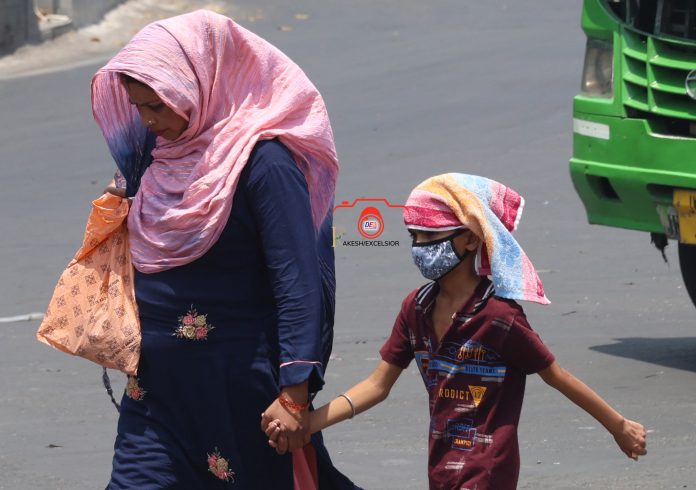- Sgr records hottest day at 31.6 degree Celsius, MeT predicts hot & dry weather for next one week; Advisory issued for farmers
JAMMU, May 22: The Kashmir valley including some parts of Jammu are simmering as the heat wave intensified across Jammu and Kashmir while the weatherman here has predicted more hot and dry weather conditions for the next one week.
Follow the Daily Excelsior channel on WhatsApp
Srinagar, the summer capital of Jammu and Kashmir, recorded the hottest day of the season at 31.6 degree Celsius.
As per the details, almost all the stations across Kashmir including Srinagar, Qazigund, Pahalgam, Kupwara, Kokernag and Gulmarg have recorded the heat wave.
In Qazigund, the mercury settled at 31.6 degree Celsius while the departure was recorded at 7.6 degree Celsius. In Srinagar, the departure temperature was 6.8 degree Celsius.
According to the data, Pahalgam and Kokernag have recorded a maximum temperature of 27.1 degree Celsius and 30.2 degree Celsius respectively while the departures at both the places were 5.5 degree Celsius and 6.6 degree Celsius correspondingly.
The Meteorological department has mentioned that Kupwara and Gulmarg, a famous ski-resort, have recorded the maximum temperature of 30.2 degree Celsius and 21.2 degree Celsius respectively. The departure at the twin places was 4.5 degree Celsius and 5.2 degree Celsius respectively.
The temperature also crossed the 30 degree Celsius mark at multiple places in Jammu division, which include Banihal, Batote, Katra and Bhaderwah while in Jammu, the mercury settled at 41.2 degree Celsius.
The Meteorological department has predicted severe heat wave in coming days with the possibility of further rise in the maximum temperature and can settle above 44 degrees Celsius in the next couple of days.
Dr Mahender Singh, senior Scientist and Incharge Agrometeorology unit of Sher-e-Kashmir University of Agricultural Sciences and Technology (SKUAST) Jammu said that as of now no major change is expected till the end of the month and day temperature, which is currently between 41 degrees to 42 degrees, is expected to cross 44 degrees in coming days, probably by May 27-28.
Giving a year-wise detailed report, the weatherman shared that the maximum temperature recorded on 26th May 1984 in Jammu was 47.4 degrees and it was an all-time record.
As per the image, on 23 May 2023, the maximum temperature recorded was 42.0, on 15 May 2022 it was 43.9, on 27 May 2021 it was 41.6, on 28 May 2020 it was 42.6, on 31 May 2019 it was 44.1, on 30 May 2018 it was 43.5, on 27 May 2017 it was 41.7, on 20 May 2016 it was 43.2, on 26 May 2015 it was 40.5 and on 29 May 2014 it was 41.8 degrees Celsius.
He said that from May 22 to 28, generally dry weather with possibility of thundershower activity at isolated places can’t be ruled out while overall there will be no significant weather activity till May 28.
He said that heat wave over plains of Jammu division with hot and dry weather over hilly districts of Jammu and plains of Kashmir would likely to continue during the next five days.
Moreover, the Agrometeorological division of the meteorological department has issued advisories for the farmers.
The Agro division asked farmers to go for nursery sowing of early transplanted rice varieties. For Rice farmers, nursery sowing Farmers may go for nursery sowing of early transplanted rice varieties. (var. IET-1410, K-39, Ratna, PC-19, Jaya) Treat seed with Carbendazim or Bavistin @2gm/Kg before nursery raising.
Incorporate the FYM @ 10-15 tons/ ha at least 15 days earlier to transplanting in the field, where rice is to be transplanted.
Fallow land pulses and other crops the farmers advised to deep plough the land with soil turning plough for soil solarization against insect pests and weed infestation. Incorporate well rotten F.Y.M. 15 days prior to sowing in the fields where Kharif maize and paddy are to be sown in June.
For vegetable farmers, the Agro division said that apply irrigation as per requirement of crop followed by ash application on wetted leaves in cucurbits for control of red pumpkin beetle. Timely harvest the matured fruit in order to avoid spoilage. Monitor tomato crop for leaf curl. Remove virus infected plants. Spray imidacloprid @ 0.5ml/lt of water to check further spread of disease by whitefly. If yellow leaves (YVMV) are observed, uproot and bury deep in soil and wash hands after that. Moreover, it also advised to keep the field free of weeds.
Poultry farmers are advised to provide adequate clean drinking water all the time for poultry birds besides proper hygiene should be maintained at the farm.
The farmers advised to get their birds vaccinated against infectious bursal dermatitis IBD & Gumbroo at 7th& 14th day after birth.
The Livestock farmers which include dairy animals, sheep & goat are advised to provide an adequate amount of fresh cool and clean drinking water, plant shady trees around the sheds, provide water baths 3-4 times in a day, install fans and desert coolers for high-yielding animals, sprinkling of water in sheds to reduce heat stress, provide good quality green leguminous and non-leguminous fodders. Maize and bajra. Urea treatment of dry straw/fodder, increase protein content in animal ration by 2% and mineral mixture should be supplemented in the diet to prevent animals from heat stress. (KNO)


